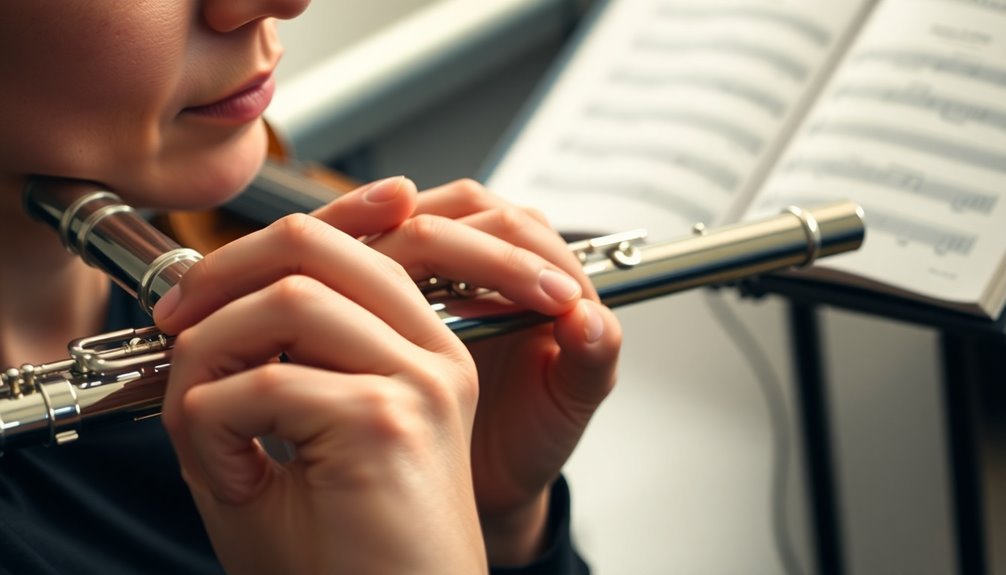To enhance your flute vibrato techniques for expressive performance, focus on these key areas. Start with strong breath support, engaging your diaphragm to create a steady airflow. Practice pitch oscillation, gradually varying speed and width to shape emotional expression. Work on finger independence and coordination to maintain fluidity. Experiment with vibrato speed; faster creates excitement, while slower evokes calm. Incorporate vibrato thoughtfully into phrasing, emphasizing key notes. Pay attention to dynamic range, varying vibrato width and intensity. Watch for common pitfalls like inconsistent speed. With dedication, you'll reveal the full potential of your vibrato—there's so much more to explore!
Key Takeaways
- Master breath control and engage your diaphragm to maintain steady airflow and support for expressive vibrato.
- Experiment with vibrato speed, using a metronome to align your oscillation with musical dynamics for emotional impact.
- Practice wide and narrow vibrato exercises, gradually adjusting speed to convey different emotions in your performance.
- Incorporate vibrato into phrasing, emphasizing climactic notes and adjusting width for tension or relaxation based on the musical context.
- Analyze performances of accomplished flutists to understand how they use vibrato to enhance emotional expression and musicality.
Understanding Flute Vibrato

Understanding flute vibrato is essential for adding depth and expression to your playing. Flute history reveals that vibrato has evolved considerably, with various styles emerging over time. As you immerse yourself in this world, remember that vibrato isn't just a technique; it's a way to convey emotion and connect with your audience.
To start, familiarize yourself with the different vibrato styles. You'll find that some flutists prefer a wide, sweeping vibrato, while others opt for a narrow, faster approach. Each style serves a unique purpose and can dramatically change the character of a piece.
Think about the emotional context of the music you're performing. Do you want to evoke a sense of longing or joy? Your choice of vibrato will play a key role in achieving that.
Listening to recordings of renowned flutists can help you identify which vibrato styles resonate with you. Pay attention to how they incorporate vibrato into their phrases, enhancing the musicality without overwhelming the melody.
Practice mimicking these styles, allowing your personal touch to shine through. Additionally, incorporating vibrato exercises into your practice routine will help refine your technique and improve tone control over time.
Basic Vibrato Technique

To master flute vibrato, you need to start with the basics of technique. A solid foundation in breath control is essential for producing a beautiful, expressive vibrato. Begin by ensuring you're using your diaphragm effectively. Take a deep breath, filling your lungs completely, and then exhale slowly, allowing your breath to flow steadily while you play. This controlled airflow will help you maintain sound quality as you begin to introduce vibrato.
Next, focus on the speed and width of your vibrato. Start with a simple oscillation in pitch. You can practice this by gently rocking your finger back and forth on the flute's keys while maintaining a steady breath. Aim for a smooth shift between notes, ensuring that your sound remains full and rich.
As you gain confidence, try varying the speed of your vibrato. A slower vibrato can evoke a sense of longing or emotion, while a faster vibrato often conveys excitement. Keep in mind that the goal is to enhance your sound quality, not overwhelm it. Additionally, diaphragmatic breathing plays a crucial role in achieving a consistent and controlled vibrato, allowing for a more nuanced performance.
Controlled Airflow Method

With controlled airflow, you can greatly enhance your flute vibrato. This technique allows you to create a more expressive sound, giving your music depth and emotion. To begin, focus on your breath support. Make sure you're taking deep, relaxed breaths from your diaphragm. This foundation is vital for effective airflow control.
Start by practicing long tones on your flute. As you sustain a note, pay attention to your air pressure. Gradually increase and decrease the flow of air without altering the pitch. This exercise helps you develop a sense of how to manipulate your breath, which is essential for achieving a controlled vibrato.
Next, experiment with different speeds of vibrato. Try to maintain a steady airflow while slightly varying the speed and width of your vibrato. Imagine your air flowing like a wave; it should rise and fall gently, creating a natural oscillation. Remember, it's important not to force the vibrato; it should feel comfortable and free.
As you practice, listen closely to how your vibrato evolves. You might find it helpful to record yourself and identify areas for improvement. Surrounding yourself with supportive fellow flutists can also inspire you to refine your technique. Additionally, developing core engagement can significantly enhance your breath control, leading to an even more refined vibrato.
Ultimately, controlled airflow and breath support are key to mastering your vibrato. Keep experimenting, stay patient, and celebrate your progress. You're part of a vibrant community of musicians, and your expressive playing will resonate with others.
Finger and Hand Coordination

Achieving effective finger and hand coordination is fundamental for mastering flute vibrato. When you develop finger independence and proper hand positioning, you'll find that your vibrato becomes more expressive and controlled. Here are some strategies to enhance your coordination:
- Practice Finger Independence: Start with simple exercises that isolate each finger. For example, while holding a note, practice moving each finger independently. This will help you gain control over your finger movements, which is essential for executing vibrato smoothly.
- Focus on Hand Positioning: Make sure your left hand is relaxed and positioned correctly. Your fingers should hover above the keys, ready to engage without tension. A relaxed hand promotes fluid motion, which is critical for vibrato.
- Use a Mirror: Watching yourself in a mirror can be incredibly helpful. Observe your hand positioning and finger movements. Make adjustments as needed to guarantee you're not creating unnecessary tension.
Here's a quick reference table to keep in mind:
| Technique | Description |
|---|---|
| Finger Independence | Isolate fingers to improve control |
| Hand Positioning | Maintain relaxed, proper positioning |
| Mirror Practice | Observe and adjust your technique |
| Consistent Practice | Regularly incorporate these techniques |
Incorporating exercises that focus on embouchure strength will further enhance your ability to control vibrato. Stay committed to these practices, and you'll see improvement in your vibrato and overall flute performance. Remember, everyone progresses at their own pace, so embrace the journey!
Vibrato Speed Variations

Vibrato speed can considerably influence the emotional quality of your flute performance. When you experiment with different vibrato speeds, you'll discover how each variation can convey a range of expressive nuances. Faster vibrato can create excitement and intensity, while slower vibrato often evokes a sense of calm or melancholy. It's crucial to recognize that the context of the piece you're playing will guide your choice of vibrato speed.
Start by practicing with a metronome. Set it to a comfortable tempo and try to match your vibrato speed to specific beats. For a faster vibrato, aim for a speed of four to six oscillations per second, while a slower vibrato might be one to three oscillations. As you develop your vibrato, pay attention to how changing the speed affects the character of your sound. Incorporating a metronome's tempo range can help you better understand how different speeds impact your playing.
When you feel confident with your vibrato speed, apply it to different musical passages. Notice how a faster vibrato can heighten tension during a climactic moment, while a slower vibrato can soften your tone during a lyrical phrase. You might even wish to vary the vibrato speed within a single phrase to create a dynamic, expressive contrast.
Don't hesitate to express yourself; your unique interpretation will set you apart. Remember, the journey to mastering vibrato speed is about exploration and finding what resonates with you. Embrace the process, and soon you'll bring out the full emotional depth of your music.
Wide vs. Narrow Vibrato

Exploring vibrato techniques doesn't stop at speed; the width of your vibrato also plays a significant role in shaping your sound. When you think about wide vibrato, envision a lush, resonant quality that can enhance lyrical passages and add emotional depth. The wide vibrato benefits include creating a more expressive and warm tone, allowing your music to resonate deeply with your audience. This technique can be particularly effective during slower tempos or expressive phrases, where you want to draw listeners into the emotion of the moment.
On the other hand, narrow vibrato applications bring a different texture to your playing. This technique is often characterized by a faster, tighter oscillation, which can add brilliance and clarity to your sound. When playing faster passages or intricate melodies, narrow vibrato can help maintain articulation and precision while still imparting a subtle expressiveness.
As you experiment with both wide and narrow vibrato, consider how each affects the overall mood of your performance. Try incorporating both into your practice sessions, alternating between the two to develop a versatile vibrato that complements your musical expression. Additionally, a well-developed vibrato technique can greatly enhance your articulation clarity, allowing for more nuanced musical phrases.
Dynamic Range in Vibrato

When considering vibrato, the dynamic range is essential for enhancing your musical expression. Mastering vibrato dynamics allows you to add depth and color to your performances, making them more engaging for your audience. To develop your dynamic range, you'll want to practice varying the speed and width of your vibrato while also adjusting the volume. This way, you can create a more nuanced emotional expression that resonates with listeners.
Start by experimenting with slow, wide vibratos at a soft dynamic. Notice how this combination can convey a sense of longing or tenderness. As you become comfortable, gradually increase the speed and volume, allowing the vibrato to become more intense. This shift can evoke excitement or urgency, drawing your audience in even further.
Don't forget to incorporate contrasts in your playing. For example, you can use a narrow vibrato at a louder dynamic to create an assertive, bold statement. This range of techniques not only enriches your sound but also showcases your personal interpretation of the music. Additionally, practicing oscillation techniques can help you achieve a more controlled vibrato.
As you practice, listen to recordings of accomplished flutists and pay attention to how they utilize vibrato dynamics. Consider how their choices enhance emotional expression in their performances.
Incorporating Vibrato in Phrasing

Incorporating vibrato into your phrasing can considerably enhance the expressiveness of your flute playing. When you think about how vibrato can shape the emotional expression of a piece, consider these key aspects of vibrato phrasing:
- Timing: Use vibrato to emphasize specific notes. By applying it during climactic moments, you'll draw your listener's attention.
- Speed: Vary the speed of your vibrato to match the emotional content of the phrase. A slower vibrato can evoke sorrow, while a faster vibrato can convey excitement.
- Width: Adjust the width of your vibrato for different effects. A narrow vibrato might create a sense of tension, while a wider one can feel more relaxed and open.
- Breath Support: Confirm that your breath support is strong and consistent. This foundation will allow your vibrato to feel natural and controlled.
As you start to incorporate these elements, try to connect with the music on a deeper level. Think about the emotions you want to convey and let that guide your vibrato phrasing. Additionally, focusing on breath support and articulation can enhance your overall tone quality, allowing your vibrato to be more expressive.
Practicing with intention will help you feel more secure in your choices and foster a sense of belonging within the musical community. Don't hesitate to experiment with different styles and techniques; you'll discover what resonates best with both you and your audience.
With time and dedication, your use of vibrato will become a beautiful part of your expressive arsenal, allowing you to communicate your musical ideas more powerfully.
Expressive Vibrato Exercises

To develop a more expressive vibrato on the flute, it is essential to practice targeted exercises that enhance control and emotional depth. These vibrato exercises will help you explore different speeds and widths of vibrato, allowing you to express a range of emotions in your performance. Let's plunge into some engaging exercises that you can incorporate into your daily practice.
| Exercise | Description |
|---|---|
| Slow to Fast Vibrato | Start with a slow, wide vibrato. Gradually increase the speed while narrowing the width. Focus on staying relaxed. |
| Dynamic Contrast | Practice your vibrato at varying dynamic levels. Begin softly, then gradually increase volume while maintaining a consistent vibrato speed. |
| Phrase Integration | Choose a short phrase from a piece you love. Apply your vibrato at different points, experimenting with placement and intensity to enhance emotional impact. |
Remember to keep your throat relaxed and your airflow steady during these exercises. You might find it helpful to record yourself, allowing you to hear your progress and identify areas for improvement. As you practice these expressive techniques, don't forget to be patient with yourself. Developing a beautiful vibrato takes time, but with consistent effort, you'll notice significant growth in your expressive capabilities. Trust the process, and enjoy sharing your unique voice through your flute! Additionally, strong breath control is crucial for achieving a steady and expressive vibrato.
Common Mistakes to Avoid

As you work on developing your expressive vibrato, it's important to be aware of common mistakes that can hinder your progress. Recognizing these vibrato pitfalls will help you refine your technique and enhance your performance.
Here are some technique errors to watch out for:
- Inconsistent Speed: A fluctuating vibrato speed can distract from the musical line. Aim for a steady pulse that complements the phrasing.
- Excessive Width: While a wide vibrato can be expressive, going too far can sound uncontrolled. Aim for a balance that enhances, not overwhelms, the tone.
- Neglecting Breath Support: Vibrato relies on proper breath support. Forgetting to engage your diaphragm can lead to a weak or shaky vibrato. Make sure to maintain a steady airflow.
- Overthinking: When you overanalyze your vibrato, it can lead to tension and stiffness. Instead, trust your instincts and practice in a relaxed state.
Additionally, incorporating mindful breathing before practicing vibrato can help you stay relaxed and focused.
Frequently Asked Questions
How Can Vibrato Enhance My Overall Flute Sound?
Vibrato can truly transform your overall flute sound.
By incorporating vibrato expression, you add richness and depth, making your tone color more dynamic and enchanting.
Experiment with different speeds and widths of vibrato to discover what resonates with your style.
This personal touch not only enhances your performance but also creates an emotional connection with your audience.
Embrace this technique, and watch how it elevates your playing to new heights!
What Are the Best Flute Brands for Vibrato Practice?
When you're choosing a flute for vibrato practice, consider Yamaha and Powell flutes.
Yamaha flutes offer excellent intonation and a smooth response, making it easier for you to develop your technique.
Powell flutes, known for their rich sound and craftsmanship, can elevate your playing experience.
Both brands provide solid options for various skill levels, so you'll find one that feels right in your hands.
Immerse yourself and enjoy the journey of mastering vibrato!
Can Vibrato Techniques Differ for Other Woodwind Instruments?
Vibrato techniques can indeed differ across woodwind instruments, showcasing their unique character.
While clarinet vibrato often relies on throat adjustments for richness, saxophone techniques emphasize air pressure variations for a smoother effect.
You'll find that exploring these differences not only boosts your versatility but also deepens your musical expression.
Embrace these nuances, practice diligently, and you'll develop a vibrant sound that connects you with both your instrument and fellow musicians.
How Long Does It Take to Master Flute Vibrato?
Mastering flute vibrato can take anywhere from a few months to several years, depending on your practice consistency and individual learning pace.
The vibrato mastery timeline varies based on factors influencing vibrato, like your previous experience and how often you incorporate it into your playing.
Stay patient and focused; progress is part of the journey. Celebrate small victories, and remember, every flutist has their unique path to achieving expressive vibrato.
You've got this!
Are There Specific Warm-Up Exercises for Developing Vibrato?
Yes, there are specific vibrato exercises you can incorporate into your warm-up techniques.
Start with breathing exercises to relax your body. Then, practice long notes while experimenting with different speeds of oscillation in your pitch.
You could also try using a metronome to help maintain a steady rhythm. Gradually increase the speed as you become comfortable.
These warm-ups not only build your vibrato but also enhance your overall sound.
You've got this!
Conclusion
Incorporating vibrato into your flute playing isn't just about technique; it's about breathing life into your music. As you experiment with these ten techniques, remember that every note is an opportunity to express your unique voice. Don't shy away from making mistakes; they're stepping stones to mastery. So, embrace the journey of discovery and let your vibrato tell a story that resonates with your audience. After all, isn't it the soul of the music that truly captivates?






